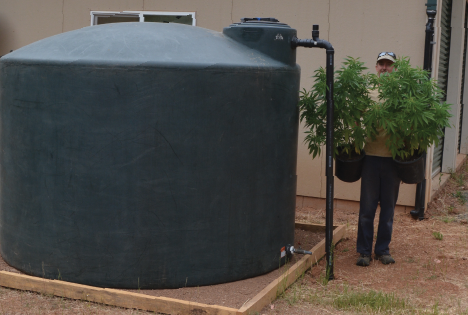
Rain-grown cannabis represents salmon safe, fish friendly farming, with many other benefits to the watershed and our communities!
For plants to grow, air and water need to flow. Soil (and its microbiology) provide a happy medium, and the sun provides photons to power photosynthesis. These elements all come together to form life on earth, the redwood forests, and our farms and gardens. When we harvest rain, we harvest abundance at the time when it is flowing through our system. When we store rainwater for use later in the year, we can use this blessing to irrigate our farms and gardens to cultivate abundance and produce a yield.
Cannabis is grown as an annual crop, and like many other annual crops it tends to be planted in the spring and harvested in the fall. In between those two seasons is the one called summer, and in the Mediterranean climate of Humboldt, summers are hot and dry in the areas that are best suited for cannabis cultivation. Thus, irrigation is most necessary in the summer and early fall, when water is scarcest and temperatures are the highest. Cannabis can be dry farmed in some areas, but for most farms, some irrigation is required. Most farms rely on groundwater, a well, or a surface water diversion.
While it is unknown what the production of a well will be in a dry year, a wiser man than myself once said “You never miss your water, ‘til your well run dry.” Even in a wet year, it is important to note pumping groundwater still depletes the aquifer, especially when the hottest, driest times of the year coincide with the peak of the growing season. An aquifer is the interstitial space between rocks, pebbles, soil, roots, and geologic formations beneath our feet. All rivers, springs, and streams are part of this aquifer, in one way or another. The volume of the aquifer is directly related to the volume of water in the river.
Depletion of the subsurface aquifer lowers the water table, which reduces instream flows, and in turn, causes stress in the plants, fish, and wildlife. The stress on forests can lead to tree mortality caused by dehydration, or bark beetle outbreaks which increases the risk of catastrophic wildfire. Decreased instream flows promote increased water temperatures, which lead to toxic blue-green algae blooms and fish mortality. Salmon need access to cool, clean water in order to migrate and spawn. The salmon depend on the forests to provide shade, erosion control, and water filtration — the forests depend on the salmon for their vital input of marine nitrogen and other nutrients their carcasses provide when they finish spawning.
Passive rainwater harvest can be designed and implemented on a farm, often simultaneously, with road maintenance or restoration efforts. Slowing down, spreading out, and sinking the stormwater flows transform a harmful force into a beneficial source of recharge for the subsurface aquifer!
By implementing forest management practices to promote wildlife habitat and biodiversity, and by reducing catastrophic fires and fuel loads, this simultaneous stacking of functions also produces a large amount of woody debris, leaves, and slash. These organic materials should be incorporated into a soil building compost, which is a huge source of soil fertility, structure, microbiology, and water retention! Reducing the amount of water required for irrigation on the farm also reduces the amount of water storage necessary.
For every one inch of rain that impacts 1,000 square feet of roof, 600 gallons of water could be captured. For example, a farm with 3,000 square feet of roof surface available for harvest — which can be the roof on a house, shop, barn, or a single 30’ x 100’ greenhouse — in a year with 60” of rainfall, there is the potential to capture over 100,000 gallons of water from that 3,000 square feet of roof.
Rigid storage tanks can be constructed of metal, plastic, or concrete above ground. Ponds are another viable option for water storage for many farms, provided they are thoughtfully designed and installed correctly by a qualified equipment operator. In addition to catching rainwater for storage, there is potential to install a rain garden, or wetland, to utilize the overflow from system. It is also worth noting that rainwater harvest does not require any water rights, annual registration, or annual fees. Large storage tanks and ponds sometimes require permits, so be sure to inform and educate yourself or consult a professional.
By capturing rain during the wet season, and storing it for use during the dry season, rainwater harvest is a critical part of temporal planning and appropriate site design and land use. Rainwater harvest is an ecologically conscious and economical alternative to diverting surface water or pumping groundwater for irrigation. Rain-grown cannabis represents salmon safe, fish friendly farming, with many other benefits to the watershed and our communities!
Rain-grown cannabis is truly kind bud — kind to the fish, forests, and families, and all that inhabit this land of milk and honey. By cultivating living soils, integrating our wastes from farm, managing our forests, and catching rain, we do more to help provide a lush and verdant future than by following in the footsteps of most of commercial agriculture. Cannabis can provide a valuable source of income for a farm to help provide the economic funding needed to develop innovative and resilient systems that will allow our way of life to evolve towards a more holistic paradigm. It is our belief that rain-grown cannabis can be a truly regenerative form of agriculture, and we look forward to seeing rainwater catchment become a crucial part of the culture and community of cannabis!
Written by Mike Black



Leave a Reply